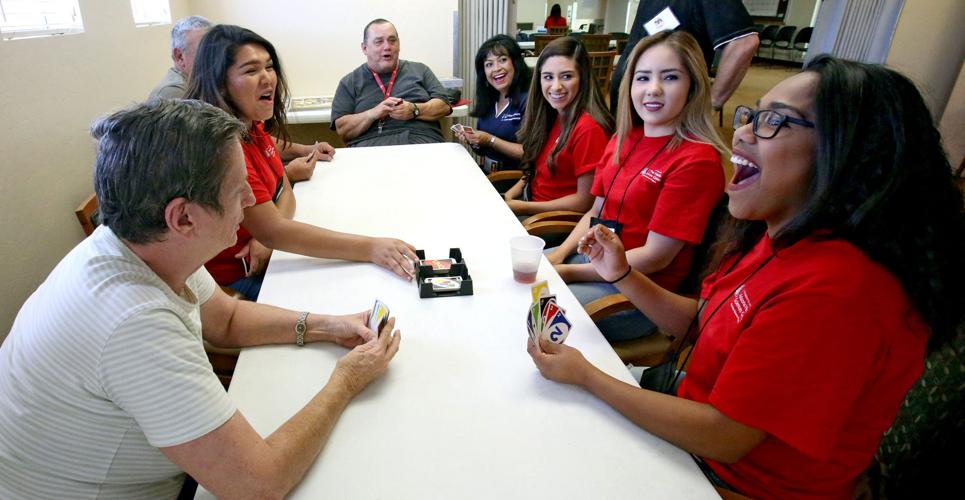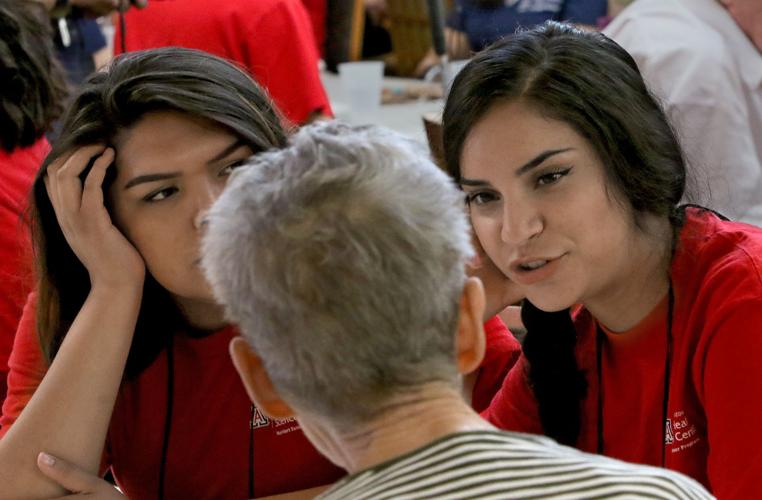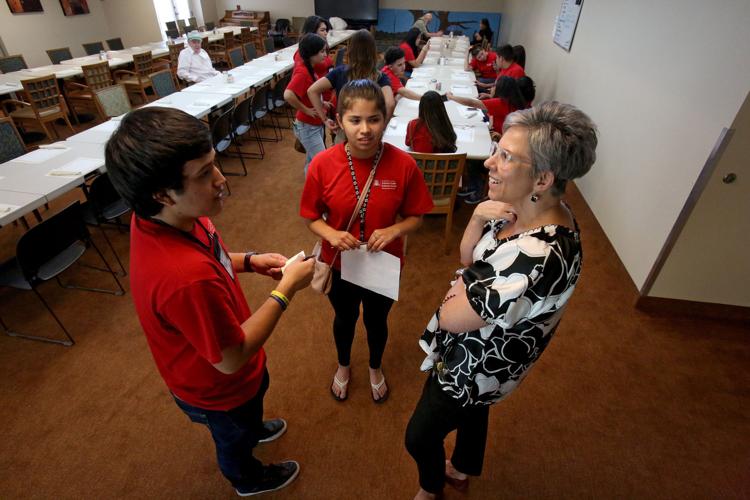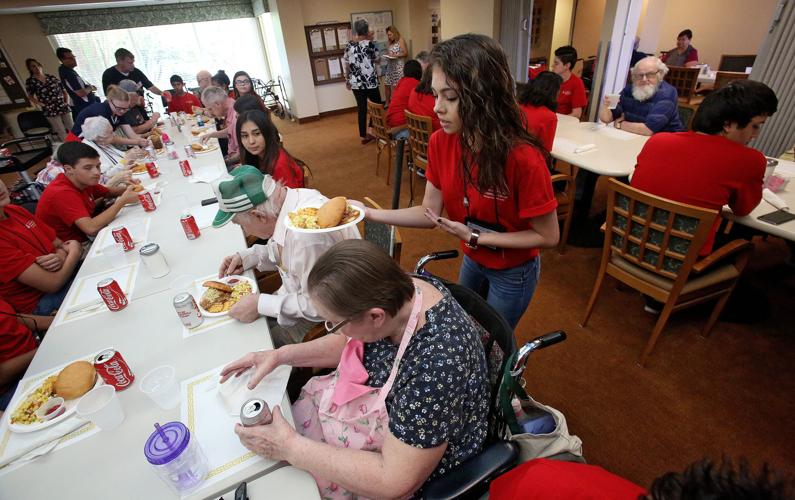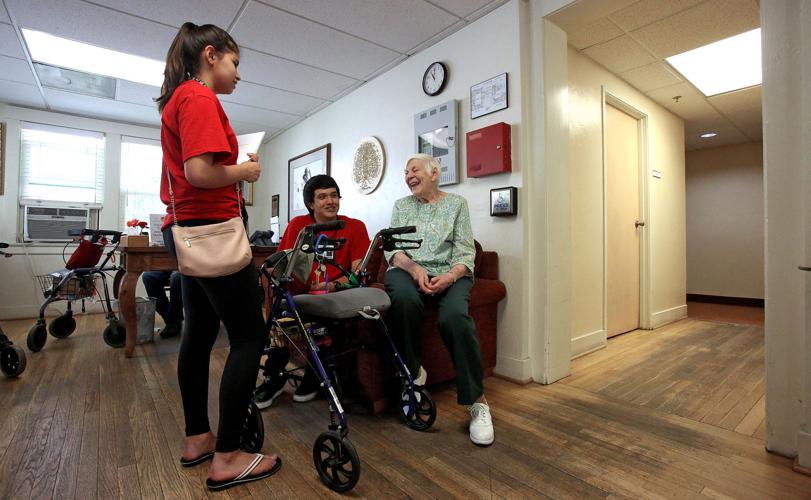St. Luke’s Home in midtown Tucson feels more like a bustling dormitory than an assisted-living facility.
It wouldn’t be a stretch, given its location near the University of Arizona. And while it is a residence for seniors, St. Luke’s is also a learning lab for aspiring medical professionals.
On a recent morning, the St. Luke’s dog, Rio, an energetic black Lab, had jumped into the fountain. Soaking wet and tracking puddles of water, he was chased through the hallway by resident elders and some visiting teenagers.
The facility’s bird, Pedro, chirped happily in an alcove. A group of residents sat in the front room socializing near a cooler full of cucumber/lemon water. In another room, more teenagers sat at a table with some elders playing an intense game of Uno.
In the dining room, a couple of residents looked over a mixed-media project they had just finished with the teens. The elder council had already decided the tree and mountain design, which will decorate the dining room wall, was missing something. They requested Tucson artist Lily Curtis help them to put an owl in the tree.
The scene was a typical one at St. Luke’s, which for many reasons is not a typical assisted-living facility. For one thing, unlike a current local trend of corporate ownership in local assisted living, St. Luke’s is not-for-profit and caters to low-income seniors.
Also, St. Luke’s is governed by its residents, who are called “elders.” The elders have a council that makes decisions on everything from the artwork in the dining room to the kind of programming they get.
Hospital avoidance
Perhaps most unique about the sprawling residence is its academic affiliation. St. Luke’s is the official academic assisted-living center of UA Health Sciences.
That academic relationship means the elders at St. Luke’s teach aspiring medical professionals and other UA students about what it’s like to age — both physically and emotionally.
The primary care and screening clinics the students hold at St. Luke’s teach them first-hand about concepts like “hospital avoidance” that they don’t always learn in the classrooms and clinical rotations, said Jane Mohler, associate director of the UA Center on Aging.
“The hospital is the worst place for these people to be,” Mohler said of the St. Luke’s elders. “Some amazing relationships have developed. The students don’t always know the older people are teaching them something, but they are.”
Students learn about speaking clearly and loudly to older people, and also about the importance of connecting and building trust. And they learn that while many of the elders have chronic conditions like asthma, anxiety disorders and diabetes, there are ways to manage those conditions to prevent future health crises.
Regular clinics held at St. Luke’s help get residents glasses and hearing devices, and with an interdisciplinary approach to their care, student nurses, pharmacists, doctors, public health students and others come up with comprehensive ways to care for the elders they see.
Social-work students from Arizona State University also participate in clinics, as do dental-hygiene students from Pima Community College.
Research with elders
Students also talk to residents for research projects.
This past school year, three UA College of Pharmacy students conducted a research project with St. Luke’s elders, including 90-year-old Elaine Coons, who said she looked forward to their visits every week.
“I felt so close to them, they were just the greatest three people and I have no doubt they’ll be back for a visit,” Coons said
The students spoke with Coons about her medications and her health, but also about other things, like her love of John Grisham books and how her hearing problem prevented her from enjoying some of her favorite films. At the end of the research project, the students gave her a captioned DVD of the movie “Lion in Winter.”
This summer, St. Luke’s partnered for the first time with the UA College of Medicine’s Med-Start program, which is for Arizona high school students who want to pursue careers in the health field.
Every Sunday for six weeks, the high school students played cards, did artwork, shared meals and socialized with the residents. Sometimes the students approached elders to interact, and other times it was vice versa. It wasn’t always easy, which is why 17-year-old Jordan Ortega said the students had a script of questions to ask to help move things along.
But Ortega, who is from Morenci and is interested in psychiatry, said he quickly abandoned the script.
“I believe they need to have someone interested in them from the outside,” he said. “I met one woman and she was alone and said she doesn’t get too involved in things here. It took her a while, but then she started telling me about herself. She had a lot of wisdom to give.”
‘Eden Alternative’
L’Don Sawyer, chief executive officer of St. Luke’s Home, says the facility is what’s known as an “Eden Alternative” community, which has a philosophy of elder care that says no matter how old we are or what challenges we live with, life is about continuing to grow.
The Eden Alternative was developed by geriatrician Dr. William Thomas when he could find nothing in his medical teachings about healing loneliness in older people.
Sawyer says the Eden Alternative model values community where life revolves around continued contact with people of all ages, as well as with plants and animals. Such relationships enrich the lives of both young and old people, she says.
At 71, Albert Heilman has been living at St. Luke’s for only a month and he’s still getting used to the fact that he’s in a senior facility and not at his own house with his girlfriend.
But Heilman said he’s had health problems, including seizures, heart attacks and diabetes.
“I didn’t think I’d ever live in a place like this. I imagined rows of beds and a nurse like Nurse Ratched (from “One Flew Over the Cuckoo’s Nest”),” he said. “Now that I am here I have no real complaints and I welcome the students. They can see that I still have a good sense of humor, that I still have some fight left in me.”
The students have been helping St. Luke’s elders with yard work,, and a few built a habitat for the two desert tortoises the facility keeps, said Med-Start program coordinator Alma Aguirre.
Personal health care
Med-Start is highly selective about the teens it chooses — 46 were selected this year from an applicant pool of 500. And the students are serious about having careers in a wide range of jobs, including paramedics, pharmacists and bio-engineering. So are some of the Med-Start staff.
“Approaching health care in a personal way doesn’t match up with what people expect,” said Nick Bruno, a 21-year-old Med-Start counselor and UA student who hopes to pursue a career in nursing. Bruno is considering specializing in critical care or rehabilitation, which would bring him in contact with a lot of older patients.
“Elders want to be treated with respect and dignity, not as though you are helping them and it’s charity,” he said. “No one wants that. Once you make the connection and establish respect, it’s a warmer connection.”
About 13 percent of the U.S. population is 65 or older, but that percentage will spike to about 30 percent in 2050, Mohler said at a recent Med-Start lunch.
She asked students and elders to share their experiences with the program. One student said she was grateful because Med-Start requires living away from home for six weeks and she’d been missing her grandmother. Others said they were considering future work with elderly people.
Mohler encouraged them to seriously consider geriatric care.
“More and more people will need our support,” she said. “People are living longer. It’s up to all of us to work together, understand each other, and benefit from each other.”


